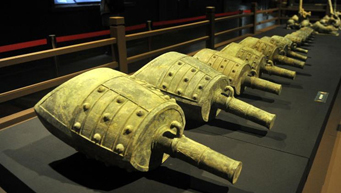Jiangxi exhibits Haihunhou cemetery finds
 0 Comment(s)
0 Comment(s) Print
Print E-mail Chinaculture.org, November 19, 2015
E-mail Chinaculture.org, November 19, 2015
 |
| Four vivid deer-shaped bronze wares are exhibited in the week-long exhibition. [Photo/Chinanews.com] |
Thousands of Nanchang locals waited in line to visit the exhibition. According to Mr. Yan, a Nanchang citizen as well as a cultural relic collector, he was eager to see the items from the cemetery.
"All the historical relics are so elegant, so amazing. I'm happy to visit the exhibition on the very first day. It is the best way to learn about the feudal hierarchy and burial system of the Western Han Dynasty," Mr. Yan said.
Several archeologists suspected that the main tomb is that of Liu He, a grandson of Emperor Wu, the greatest ruler of the Western Han Dynasty, one of the most prosperous periods in Chinese history. Liu was given the title "Haihunhou" after he was deposed as emperor after only 27 days, dethroned by the royal clan because of his lack of talent and morals. Haihun is the ancient name of a very small kingdom in the north of Jiangxi.
Current important archaeological findings include a bronze pot containing chestnuts which may further prove the popularity of China's hot pot cuisine among ancient aristocrats, a pair of goose-shaped bronze lamps that can "swallow" smoke, chimes as well as other musical instruments, Wuzhu coins and gold coins and hoof-shaped ingots.
The cemetery is also identified as the only tomb excavated south of the Yangtze River with real vehicles.
Jiangxi's provincial cultural department documented information and data with the help of advanced sampling and recording technologies during the whole excavation. Several labs and research teams have been set up to work separately on archaeo-botany, zoo-archaeology as well as studies on textiles, metals and historical records.





Go to Forum >>0 Comment(s)